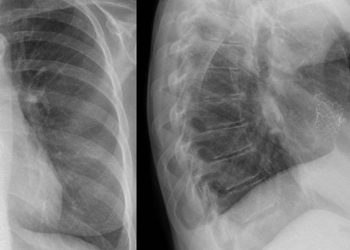[Physician Comment] Recurrent early Lyme disease is caused by reinfection, not relapse
Image: PD
Study Author Dr. Robert Nadelman, MD talks to 2 Minute Medicine Division of Infectious Diseases, New York Medical College:
“Our findings should reassure clinicians and patients that standard courses of appropriate antibiotics regularly cure early Lyme disease associated with an erythema migrans skin lesion, and that recurrences of erythema migrans are reinfections (transmitted by a new tick bite), rather than relapses. Our results are also consistent with existing clinical and epidemiologic information. For instance, recurrent erythema migrans skin lesions develop after one year or more at a different body site than the original lesion, and occur during the summer at the height of activity of nymphal Ixodes scapularis (deer ticks); a preceding new tick bite at the exact site of the recurrent rash was recalled by 27% of our patients.
Persons living, working, or spending time in recreation in areas endemic for deer ticks remain at risk for tick-borne infections including repeat episodes of Lyme disease. Therefore, efforts should be made to educate the community on how to avoid tick bites, and on the importance of removing ticks as soon as possible before they can transmit infection.”
Key study points:
- Cases of recurrent Lyme infection were caused by different strains of B. burgdorferi versus initial infections.
- Recurrent Lyme appears to be caused by reinfection, not relapse.
Primer: Lyme disease is a tick-borne infection caused by the spirochete Borrelia burgdorferi. Incidence of Lyme infection has been steadily increasing for several decades, particularly in the Northeastern United States.
Lyme infection causes a multi-stage disease beginning with a febrile illness and characteristic rash called erythema migrans (EM). If left untreated, patients can develop disseminated disease that may involve multiple EM lesions, neurologic and/or cardiac involvement.
Lyme can generally be treated successfully with antibiotics, but a small number of patients experience recurrent or persistent symptoms after appropriate treatment. These cases of “recurrent” and “chronic” Lyme disease have been a source of controversy. Many patients and advocacy groups believe in extending antibiotic courses for years to prevent relapsing and chronic disease, while the Infectious Diseases Society of America does not believe there is evidence to support this practice.
Case reports and epidemiologic data suggested that recurrent Lyme results from reinfection, though this assumption had not been definitively supported. To determine whether recurrent Lyme is indeed caused by reinfection, the authors of this study compared the Lyme genotypes of patients with recurrent Lyme disease to the genotypes of their consecutive preceding infections. Of note, this study specifically addresses the issue of recurrent early Lyme, not disseminated or late disease.
Background reading:
1. Clinical manifestations of Lyme disease in adults.
2. Reinfection in patients with Lyme disease.
3. Reinfection and relapse in early Lyme disease.
This [molecular typing] study examined data and specimens collected from prior prospective studies of Lyme disease. Twenty-four episodes of recurrent EM with positive cultures (referred to as paired consecutive episodes) were identified in 17 patients; however only 22 episodes had adequate samples for genotyping. B. burgdorferi DNA was extracted from positive skin or blood cultures for each episode of EM and used to determine the pathogens’ genotypes. In all cases, no two consecutive episodes of Lyme infection produced the same strain of B. burgdorferi, suggesting these recurrent episodes resulted from reinfection rather than relapse of the prior infection.
In sum: This is the first study to evaluate a cohort of patients for evidence of reinfection in recurrent Lyme disease. By comparing genotypes of the outer surface protein C (ospC) of Lyme isolates obtained in initial and recurrent episodes of EM, this study showed in all cases for which sufficient data was obtained that recurrent Lyme was indeed caused by reinfection. These results could also suggest that there may be type-specific immunity to Lyme genotypes, though the study was not statistically powered to clearly address this possibility. Additionally, 2 of the 24 culture-positive paired episodes of EM were unavailable for genotyping. Therefore relapsing infection cannot be ruled out in these cases. Though logistically difficult, a prospective study may be helpful going forward to further support the notion that recurrent early Lyme is indeed caused by reinfection.
Click to read the study in [NEJM]
Click to read an accompanying editorial in [NEJM]
By [AS] and [MP]
© 2012 2minutemedicine.com. All rights reserved. No works may be reproduced without written consent from 2minutemedicine.com. Disclaimer: We present factual information directly from peer reviewed medical journals. No post should be construed as medical advice and is not intended as such by the authors or by 2minutemedicine.com. PLEASE SEE A HEALTHCARE PROVIDER IN YOUR AREA IF YOU SEEK MEDICAL ADVICE OF ANY SORT.



![2 Minute Medicine: Pharma Roundup: Price Hikes, Breakthrough Approvals, Legal Showdowns, Biotech Expansion, and Europe’s Pricing Debate [May 12nd, 2025]](https://www.2minutemedicine.com/wp-content/uploads/2025/05/ChatGPT-Image-May-12-2025-at-10_22_23-AM-350x250.png)
